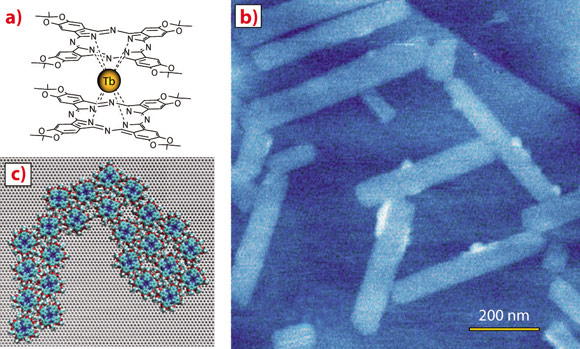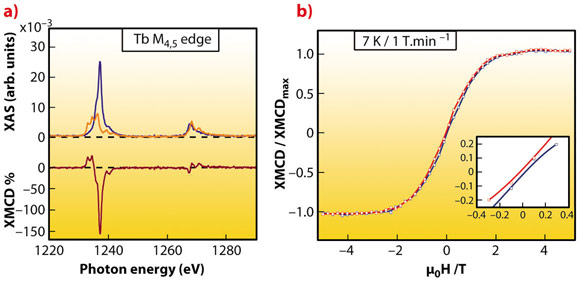- Home
- Users & Science
- Scientific Documentation
- ESRF Highlights
- ESRF Highlights 2011
- Electronic structure and magnetism
- Organising single-molecule magnets on surfaces while preserving their magnetic properties
Organising single-molecule magnets on surfaces while preserving their magnetic properties
Device miniaturisation pushes towards the single-molecule level. Single molecule magnets (SMMs) are molecules presenting a high spin ground state and a high magnetic anisotropy, therefore exhibiting slow relaxation of magnetisation which translates to the occurrence of hysteresis in the magnetisation at low temperature. The ability to retain its magnetic state is the main characteristic of a memory unit, and occurs in SMMs at the single-molecule level. A lot of effort has been dedicated over the past few years to the preparation of new SMMs, trying to push-up their blocking temperatures, with the idea that they might prove useful for data storage or spintronic applications. Before this could happen, it is imperative to check that the properties of the SMMs can be preserved when deposited on a surface. For this reason, we carried out a detailed experimental and theoretical study of the 2D supramolecular organisation on graphite of iPc2Tb, a well known double-decker phthalocyanine Tb(III) complex that exhibits SMM behaviour in the crystalline state.
When drop cast from a toluene solution onto highly-oriented pyrolitic graphite (HOPG), iPc2Tb self-assembles into anisotropic two dimensional nanocrystals one molecule thick and aligned along the graphite symmetry axes, as shown by atomic force microscopy (see Figure 83). This morphology was rationalised by molecular dynamics simulations which provided excellent agreement with the experiment, showing that − after diffusion on the graphite surface − the molecules self-assemble into nanoscopic islands which align preferentially along the three main graphite axes, and in which the molecules lie flat on the surface. These low dimension assemblies of independent magnetic centres are ideal to study the influence of the surface on the properties of those SMMs, since all of the molecules are in interaction with the graphite substrate and could therefore be perturbed by it.
 |
|
Fig. 83: a) Structure of the iPc2Tb complex, b) AFM image of the rectangular 2D islands formed by drop casting iPc2Tb on HOPG from a toluene solution, and c) self assembled 2D aggregates obtained from the MD simulations. |
Due to the very small amount of magnetic material in the sample, the detection of the magnetic properties of the self-assembled bar-shaped islands of iPc2Tb on HOPG was not a trivial experiment, and was made possible by using beamline ID08 to perform X-ray absorption (XAS) and the related magnetic circular dichroism (XMCD) spectroscopy at the M4,5 edge of terbium at low temperature (7 K) and high magnetic field (5 T). We were able to reproduce the experimental spectra by means of multiplet calculations and validate the applicability of sum rules to the present case, which allowed us to determine the orbital and spin moments of the molecules [1]. The comparison of XAS measurements with the spectra simulation as a function of the molecule orientation led us to ascertain the adsorption geometry of the molecules. They lay flat when adsorbed on graphite, as suggested by the microscopy and molecular dynamics results. The magnetisation curves as a function of the applied magnetic field were recorded as well (Figure 84b).
 |
|
Fig. 84: a) Polarised XAS and resulting XMCD spectra and b) XMCD intensity hysteresis loop of the submonolayer samples of iPc2Tb on HOPG at 7 K. |
Our experiments showed that the iPc2Tb complexes preserve their spin and orbital moments despite the interaction with the graphite substrate. Furthermore, the magnetisation hysteresis, although slightly narrower, is preserved also at T = 7 K, which was not the case with different substrates. Therefore the iPc2Tb molecules on graphite widely retain their SMM behaviour, demonstrating their potential for future applications in hybrid organic/inorganic spintronic systems when associated with suitable substrates. These results, in particular, pave the way for the use of Pc2Tb compounds with graphene, to prepare novel spintronic devices [2].
Principal publication and authors
M. Gonidec (a,b), R. Biagi (c,d), V. Corradini (d), F. Moro (e), V. De Renzi (c,d), U. del Pennino (c,d), D. Summa (f), L. Muccioli (f), C. Zannoni (f), D.B. Amabilino (a) and J. Veciana (a,b), J. Am. Chem. Soc. 133, 6603–6612 (2011).
(a) Institut de Ciència de Materials de Barcelona (ICMAB-CSIC), Bellaterra (Spain)
(b) Networking Center on Bioengineering, Biomaterials and Nanomedicine (CIBER-BBN), Bellaterra (Spain)
(c) Dipartimento di Fisica, Università di Modena e Reggio Emilia, Modena (Italy)
(d) S3 Istituto Nanoscienze-CNR, Modena (Italy)
(e) School of Chemistry, University of Nottingham (UK)
(f) Dipartimento di Chimica Fisica e Inorganica and INSTM, Università di Bologna (Italy)
References
[1] R. Biagi, J. Fernandez-Rodriguez, M. Gonidec, A. Mirone, V. Corradini, F. Moro, V. De Renzi, U. del Pennino, J.C. Cezar, D.B. Amabilino and J. Veciana, Phys. Rev. B 82, 224406 (2010).
[2] S.J. Gong, Z.Y. Li, Z.Q. Yang, C. Gong, C.-G. Duan and J.H. Chu, J. Appl. Phys. 110, 043704 (2011).



